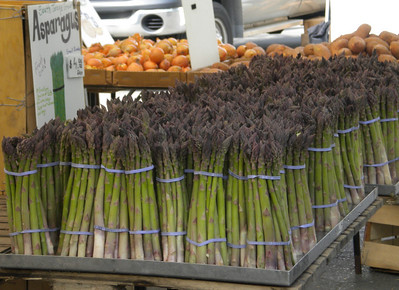
This Earth Day I’m hitting the farmers’ market. To me, nothing says “green living” or springtime like locally grown food. From familiar spring vegetables such as asparagus and leeks to the rare morel and rhubarb the market provides a wealth of vibrant, flavorful produce for my dinner plate.
Of all the vernal offerings the most unusual has to be the fiddlehead fern. Resembling the carved head of a violin, fiddleheads are the unfurled shoots of an ostrich fern. One of the last true wild, foraged foods, they grow in moist woods, floodplains and, in my case, in the damp soil bordering my 19th century farmhouse.

When told by a neighbor that the two-inch long, tightly coiled fern leaves tasted like a cross between asparagus, artichokes, and okra, I assumed that he was joking. Making fun of the city slicker, eh? What would he say next? That sautéed maple leaves reminded him of syrup?
Skepticism aside, I gave fiddlehead ferns a try. Boiled in lightly salted water for 10 minutes or steamed for 20, they do evoke this unusual combination of flavors.
Although traditionally topped with butter, salt and pepper, the vegetable’s distinct taste and firm texture make it a good match for stir fries as well as Hollandaise, cheese and tomato sauces. If stir-frying, remember to blanch the ferns in boiling water before tossing into your wok. Some food-borne illnesses have been attributed to raw or undercooked fiddleheads.
With a season of just two weeks fiddleheads fly out of markets. As they have a short shelf life, they should be consumed within two days.
Along with fiddleheads I stock up on stalky, red rhubarb. Although botanically a vegetable, rhubarb has masqueraded as a fruit since 1947. That year the United States Customs Court in Buffalo, New York deemed it a fruit because of the manner by which it is eaten. In the U.S. rhubarb is traditionally coupled with strawberries and baked in desserts, particularly pies. In fact, its popularity as a pie filling has garnered it the nickname “pie plant.”
Elsewhere rhubarb retains its vegetable identity and appears in savory dishes. In Poland it is cooked with potatoes and spices. It turns up in stews in Iran and with spinach in Afghanistan.
Because of rhubarb’s intense tartness and my lifelong preference for sweets, I invariably pair it with a generous amount of sugar. Once sweetened, it creates velvety jams, sauces and desserts such as rhubarb crumble, trifle, and pie.
When selecting rhubarb, look for moderately thin, pink or red stalks. Thicker, greenish stalks will be sour and stringy. Use non-aluminum cookware with this fruit. Otherwise, the rhubarb will react with the metal.
RHUBARB CRISP
Serves 6
4 cups of rhubarb, cut into 1” pieces
¾ cup granulated sugar
1 ½ teaspoons cinnamon
¼ teaspoon ginger
juice of half of a lemon
¾ cup of light brown sugar, firmly packed
½ cup of all purpose flour
¾ cup of rolled oats
¼ cup of unsalted butter at room temperature
Preheat the oven to 375˚. Grease a 9”x 9” baking dish then set aside.
In a bowl mix together the granulated sugar, ½ teaspoon of cinnamon, and ¼ teaspoon of ginger.
Place the rhubarb in the baking dish then sprinkle the sugar mixture and the juice of half of a lemon over the top.
In another bowl mix together the brown sugar, 1 teaspoon of cinnamon, flour, and rolled oats. Using your fingers, break up the butter into small pieces and add to the dry ingredients. With a fork mix the butter, oats, sugar and flour together until they are well combined. Sprinkle the topping evenly over the rhubarb.
Place the baking dish in the preheated oven. Bake until the crust has browned and the rhubarb is bubbling, about 25 minutes. Serve with a scoop of vanilla or strawberry ice cream.